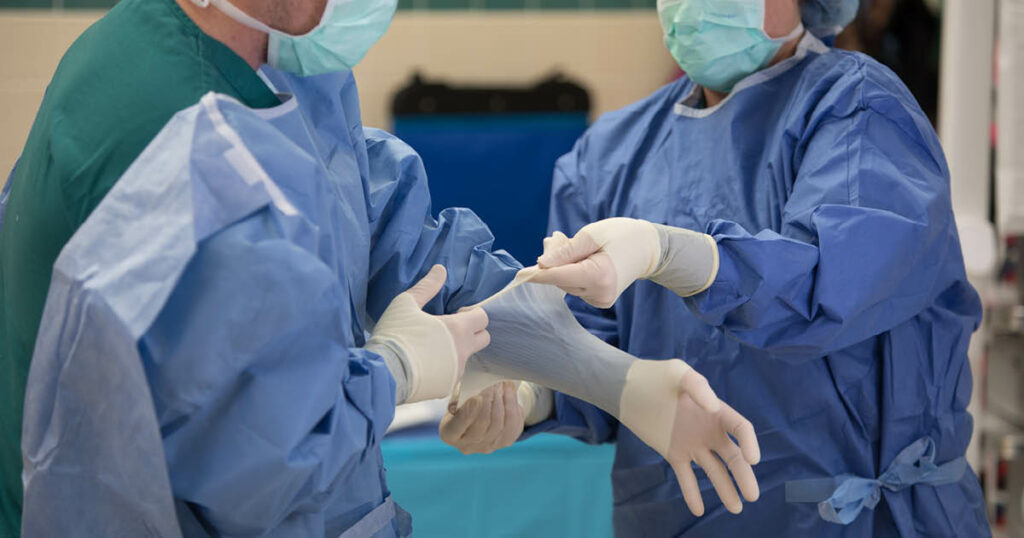Many images come to mind when we talk about infection protection. Gloves, face masks, gowns, coveralls, and other protective clothing. However, when it is about, your selection should be based on your needs. First and foremost, it should be free of contamination. Second, it should be comfortable. Many people are unsure how to choose between Reusable and Disposable Isolation Gowns. So, let’s take a closer look at their differences and advantages.
Levels of protection with gowns
Here are some distributed levels of gowns according to the protection.
Level 1
Level 1 disposable isolation gowns provide the bare minimum of protection. In most cases, hospitals or medical users provide these gowns but do not use sterile gowns. They also provide a thin barrier against fluids. However, it is not appropriate for blood draws, intensive care units, or pathology labs.
Level 2
Those with level 2 protect blood draws from veins and work in pathology labs and intensive care units. By impacting the gowns with water, these gowns pressurize the material used to make the gowns. Furthermore, these gowns can block more fluid than level 1 gowns.
Level 3
Gowns in this category are suitable for moderate situations. Blood draws from arteries, IV insertions, and ER use of sterile gowns. They also shield you from splatters and soaking.
Level 4
Level 4 disposable isolation gowns provide the highest level of protection available and are appropriate for all high-risk situations. These heavy-duty gowns can protect against fluid and virus penetration while also containing blood. These gowns provide pathogen resistance as well as protection from non-airborne diseases. And act as a barrier to large amounts of fluids for long periods.
Difference between reusable and disposable isolation gown
As discussed above gowns are categorized according to protection. You can discard disposable isolation gowns after once. And made from non-woven materials that offer higher protection from liquids. Whereas reusable even after a wash. These are made from non-woven fiber bonding to provide higher integrity and strength.
Here are some how reusable and disposable gowns can help you.
Pros of reusable isolation gowns
Hospitals typically use reusable isolation gowns. It’s less expensive and reused. Furthermore, this is a more environmentally friendly option that generates less waste. These are made of cotton or a cotton blend and are better with each wash cycle. They prevent fluid penetration and liquid transmission by providing filtering media and reducing capillary formation.
Barrier effectiveness, functionality, comfort, cost-effectiveness, strength, and quality maintenance are some examples. You can also contact to buy disposable isolation gowns in bulk to distribute among the community.
Cons of reusable isolation gowns
Even after counting so many reusable gowns, we are here to serve with some disadvantages. Reusable gowns are at greater risk of cross-contamination. Such as between patients, doctors, nurses, and hospital workers. Even personal assistants can get infected even after using or handling them. And if they are not correctly handled or washed, they can pose a threat. Furthermore, contaminated gowns pose a high risk of exposure to bloodborne pathogens.
Pros of disposable isolation gowns
We, on the other hand, have disposable gowns. It is the same as the disadvantages of reusable gowns. Surprising, but true. Because you dispose of them after each use, there is less cross-contamination. Furthermore, these gowns are made of protective fabric that repels water and other fluids. You can also contact to buy disposable isolation gowns in bulkto distribute among the community.
Disposable isolation gowns provide fluid barrier protection against blood draw penetration. Because of this, they are ideal for COVID-19 isolation settings. These are typical woven fabrics designed to fill the void left by reusable gowns. In addition, medical professionals must be adequately protected from contagious diseases.
Non-woven fabrics for disposable gowns are from unused fibers that have been recycled. These non-woven fabrics may also be made of polyethylene, a thermoplastic. Furthermore, the material used in this gown makes it light but strong enough to replace foreign liquids that enter our skin. A loom creates the woven fabrics used to make reusable isolation gowns. You can also contact to buy disposable isolation gowns in bulk to distribute among the community.
Disposable gowns make it simple to clean up spilled waste. And all without coming into contact with any fluids on your skin. Even if you are wearing a gown, these infectious liquids can cause contamination. Even when cleaned, infectious pathogens are washed off with a reusable gown. Contact PPE Distributors for a genuine buy of PPE clothing. Furthermore, because disposable isolation gowns are pre-packaged, they are sterile, preventing wound contamination.
Cons of disposable isolation gowns
While disposable gowns provide an additional layer of protection to all users. Whether they are patients or healthcare workers, they are environmentally conscious. Furthermore, they frequently dispose of it in a patient’s room. Second, a soiled gown can sit in the trash for a longer period before being properly disposed of.
Conclusion: You can protect yourself and others by wisely choosing your protective clothing. And among the two reusable and disposable gowns, you can differentiate with the above pointers.
Frequently Asked Question
Q1.When should you wear a gown?
A surgical gown is a personal protective garment designed to protect both the patient and the health care personnel during surgical procedures.
Q2.How frequently can disposable equipment be used?
Disposable PPE is intended to be used only once by one person and cannot be washed.
Q3.What precautions would you take if you were wearing a gown?
Gowns. Isolation gowns are used as part of standard and contact precautions to protect healthcare workers’ clothing and arms.
